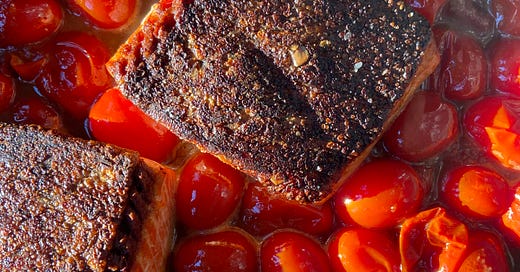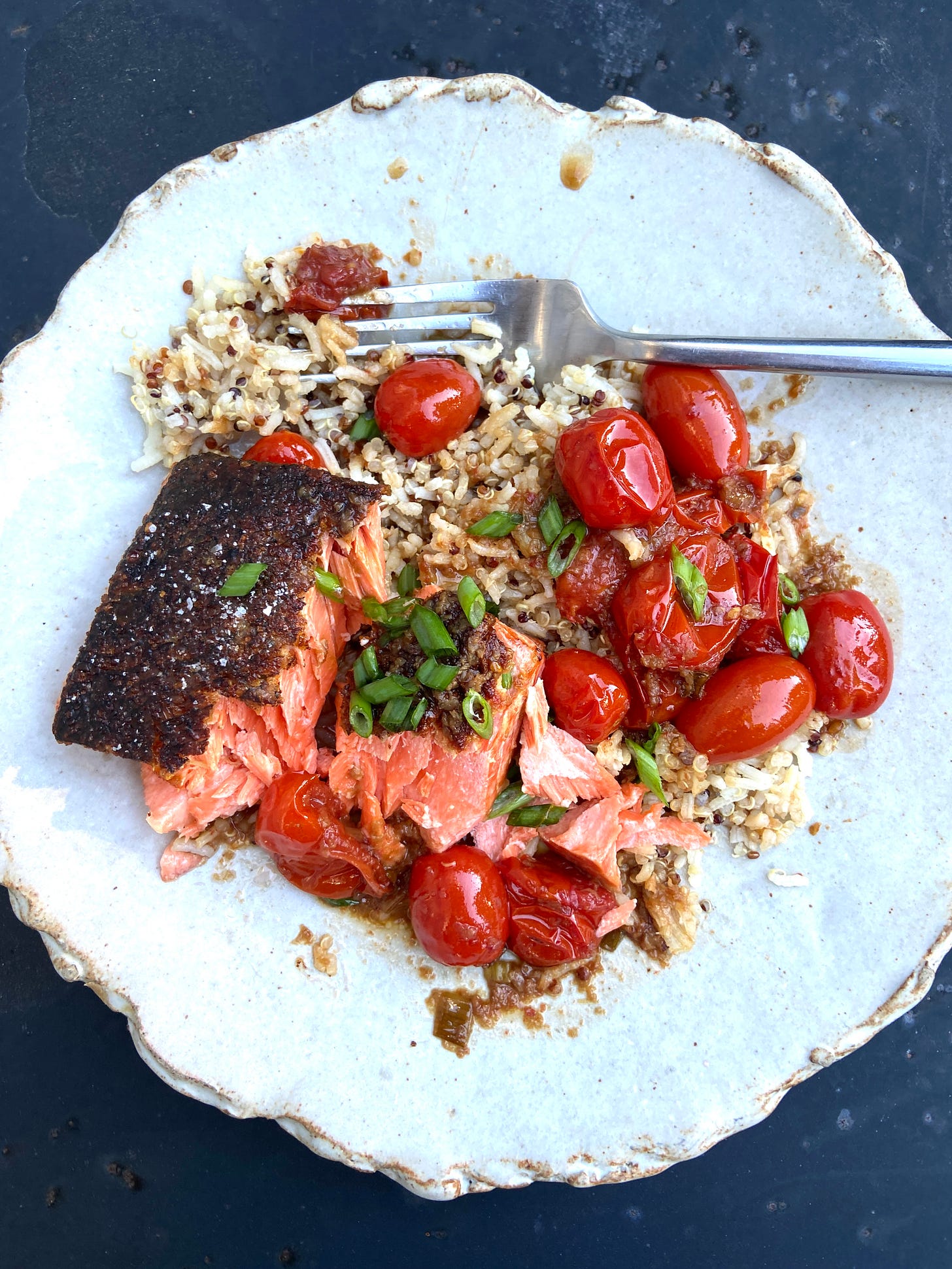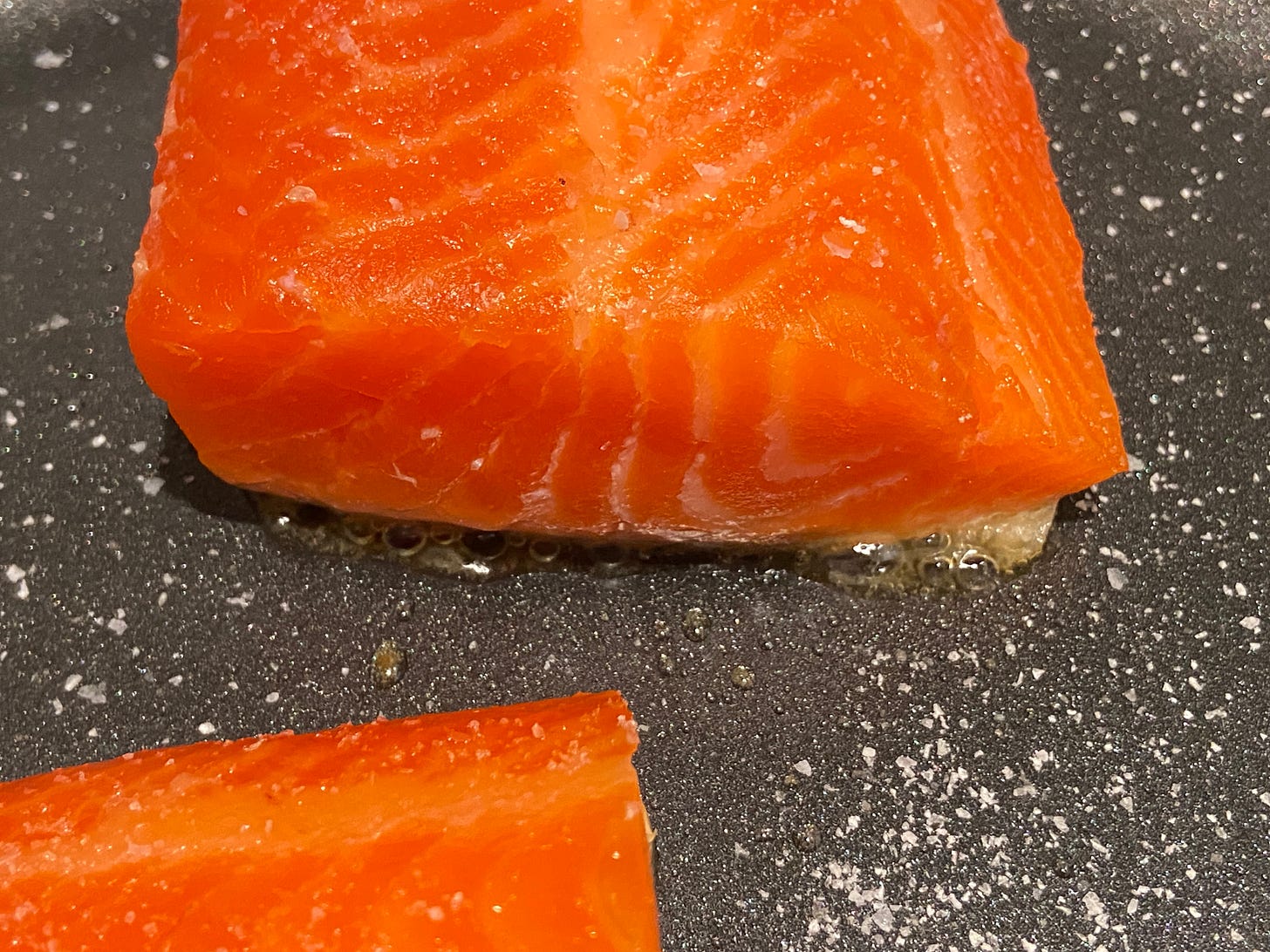“I’ve loved your work for a while and as a mom to an active one year old I love how accessible and delicious your recipes are (and how they are written for max efficiency!)” — Cece, paid subscriber
Here at 40 Ingredients Forever, recipes are abundant in flavor and joy yet streamlined in process — because they’re all made of the same 40 ingredients.
Chicken skin gets lots of love. It’s golden, crackly, delicious, yeah, but what about fish skin?
It can get just as brittle and shattery — a welcome contrast to the silky meat beneath. Fish skin is salty, umami-y, and ocean-y, maybe more so than the meat. It’s a freebie many of us (me included) often toss. Because its appeal hinges on its texture: It has to be crispy.
For all the perks of baking fish, it’ll leave you with soggy skin, which is as unappealing as flabby chicken skin. For something snappy like a chip, broil or grill the fish, or, like, cook it in a skillet.
Many (restaurant-y) recipes for crispy-skinned fish tell you to use a very hot, oiled skillet, but that can cause the fish to buckle and splish splash splatter hot oil. This super-fast method can also be too fast, leaving the skin burnt on the surface yet soggy underneath.
Instead, I take a more mellow approach that fully renders the skin and keeps the meat tender. Pat the fish very dry and season it all over with salt, then put it skin side down in a cold pan, without any oil. Fish skin has plenty of fat; our job is to eke it out so the fish can cook in its own fat. Turn the heat on, but just to medium so the skin can slowly, gently, fully heat and sizzle out its fat. (Do this for bacon, too.)
Then leave the fish on its skin side until the meat is opaque three-quarters of the way up the sides, with just the top quarter still raw. The skin serves as a protective layer between the heat of the skillet and the delicate meat, almost like a heat diffuser, so the meat has a harder time getting chalky and dry. By this point too, the skin has had enough time to crisp and unclench from the pan. (There’s some light science about why this happens in my article about grilling salmon.)
All that’s left to do is flip the fish and cook the top for just a minute or two. Or! You can use this moment to make a little pan sauce and finish cooking the fish, now skin side up, in a shallow pool of something soft and saucy. In today’s recipe, there are buttery, soy sauce-slicked burst tomatoes. The skin stays crackly up above the sauce, while the meat stays silky-soft amongst the jammy, saucy tomatoes.
Recipe Family Tree
These recipes inspired this one; maybe they’ll inspire a dinner for you, too?
Skillet salmon with soy-butter tomatoes
Serves 4
4 (5- to 7-ounce) 1-inch-thick fish fillets, such as salmon or trout
Salt
4 scallions
4 garlic cloves
1 (2-inch) piece of ginger
4 tablespoons unsalted butter
2 pints cherry tomatoes
3 tablespoons low-sodium soy sauce
Steamed white rice, for serving
1. Season 4 (5- to 7-ounce) 1-inch-thick fish fillets, such as salmon or trout, all over with salt. Place the fish skin-side down in a large (12-inch) nonstick or cast iron skillet, then heat over medium. (You don’t need oil because the salmon skin will release enough fat to prevent sticking.) Cook until the skin is crispy and the flesh is opaque 3/4 of the way up the sides, 6 to 12 minutes. If the fish is buckling, press it down with a spatula so it makes contact with the skillet. Transfer to a plate, skin-side up (the fish will not be fully cooked).
2. Meanwhile, thinly slice 4 scallions, keeping the light and dark parts separate. Peel and finely grate or chop 4 garlic cloves and a 2-inch piece of ginger.
3. In the same skillet over medium heat, melt 4 tablespoons butter. Add the light scallion parts, garlic, and ginger and stir until fragrant, about 1 minute. Add 2 pints cherry tomatoes, ¼ cup water, and 3 tablespoons low-sodium soy sauce. Simmer, shaking the pan occasionally and pressing on the tomatoes, until tomatoes start to burst, 5 to 7 minutes. Nestle the salmon, skin-side up, among the tomatoes and continue cooking until salmon is cooked through, 1 to 2 minutes. Serve topped with the scallion greens and alongside rice.
PRINT THIS RECIPE
SWAPS
Fish: This super savory sauce would be good with a number of mild proteins. Sear boneless or bone-in chicken on one side until browned and mostly cooked through, then proceed. Add chickpeas or cubed, firm tofu in the last 1 to 2 minutes of the tomatoes simmering. Just make the soy-buttered tomatoes and eat it with a fried, poached, or scrambled egg. Oh oh, simmer dumplings in the sauce!
Scallions, garlic, and ginger: This combination of aromatics is pretty flexible. Swap in thinly sliced leeks, green garlic, or finely chopped onion or shallot.
Cherry tomatoes: When they’re in season, you could use ripe, larger tomatoes cut into bite-size pieces. You could also use whole, peeled canned tomatoes; drain the liquid from the can and just use the tomatoes.
Soy sauce: fish sauce, miso, or maybe black vinegar?
Steamed white rice: Eat it with another grain, like quinoa or farro — or over noodles (like soba or ramen) or vegetables (like sauteed kale or broccoli).
Recipe testing: Theo Kaloudis










Made this, much to the delight of the little food critics! Also loved learning something new! Will certainly apply these techniques again. Thank you for sharing, much appreciated.
I made this tonight! It was so good! Next time I'll try it with eggs.